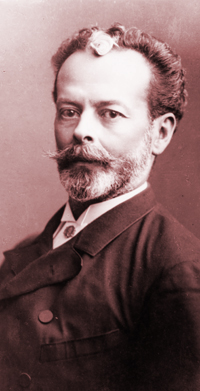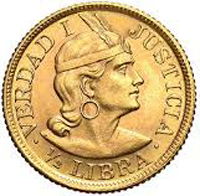
10 CENTAVOS COIN - PERU - RADIANT SUN WITH FACE
(KM 198)
Date: A.D. 1880
Obverse: Radiant sun with a face - REPUBLICA PERUANA 1880 - DIEZ CENTAVOS
Reverse: MONEDA PROVISIONAL 10 CENTAVOS
Mint: Royal Belgian Mint in Bruxelles
The gold Libra Peruana issued in Peru between 1898 and 1931 with a value equal to the British Sovereign |
This coin was minted in 1880 by the Royal Belgian Mint in Bruxelles for the Republic of Peru. It was minted during the War of the Pacific (1879-1883) between Chile and an allied Bolivia and Peru. In 1880 Peru was under the rule of Nicolás de Piérola, a former Finance Minister, who staged a successful coup in 1879 against President Mariano Ignacio Prado who was out of the country at the time seeking money and munitions for the war. This was not his first attempt to overthrow President Prado. In 1877 agents of De Piérola hijacked the ironclad Huáscar but were defeated by British ships loyal to Prado forcing De Piérola to surrender after which he went into exile. Upon his return in 1879 he again launched a coup d'état with the support of many in the military that resulted in heavy fighting and casualties on both sides. This time he was successful in defeating the forces loyal to Prado and assumed full power on December 23, 1879 declaring himself the "Supreme Commander in Chief". After securing the loyalty of most of the army, De Piérola turned his attention to the ongoing conflict against Chile while also securing his positions as supreme commander. He took measures to censor the press and opposition to his rule. He also purged the army of those who he believed were disloyal to him, replacing them with generals who were political allies. The military suffered defeats against Chilean forces at Tacna and Arica forcing De Piérola to move his remaining troops to Lima to join citizen volunteers in a defense of the capital where Peruvian forces were again defeated. The city of Lima fell and parts of the city were sacked and burned and De Piérola fled the city with what remained of his forces. As Chilean forces took Lima and set up their own government, De Piérola was forced to resign and hand over command and the presidency to General Andrés Avelino Cáceres who would lead a guerrilla resistance to Chilean occupation. By 1894 the ever resiliant De Piérola would again seek the presidency by coup, this time against Cáceres. Riding into Lima in command of loyal guerilla fighters, his third attempt at a coup would be a violent one that would cost over a thousand lives but it was successful and he once again become the President of Peru on September 8, 1895. His government would be known as the "Aristocratic Republic" because power was handed over to the wealthy "elite" who created an exclusionary government run by a powerful ruling class. During his four year term he concentrated on reconstruction and modernization of Peru which had been devastated by the war as well as military and economic reform. As part of his economic reform De Piérola issued the "Libra Peruana", a gold coin equal to the value of a British Sovereign which helped to stabilize the economy and minimize the post war recession. Eduardo López de Romaña won the election of 1899 and he stepped down peacefully. After his presidency his political pominence faded but he was not quite ready to retire. After a failed bid to become mayor of Lima in 1900, and an aborted plan to run for the presidency again in 1904, he supported the failed attempt by his brother and sons to overthrow President Augusto Leguía in 1909. They stormed the Palacio de Gobierno demanding his resignation but Leguía refused to resign so they kidnap him. The police later rescued the president during a fight that took the lives of more than 100 people. Nicolás de Piérola would never hold another political office. He died in Lima on June 23, 1913 at the age of 74. |


